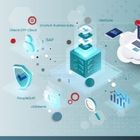Finance and IT in Digital Transformation


Bridging the Gap: The crucial partnership between finance and IT in digital transformation
The importance of the partnership between finance and IT in driving successful digital transformation may seem obvious, but recent insights from a Forrester survey of finance and IT executives shed light on persisting challenges. The survey revealed that nearly two-thirds of respondents acknowledged continued silos between the two departments, leading to a lack of alignment, complicating their ability to streamline processes and adopt digital technology seamlessly.
As organizations increasingly seek a competitive edge through digital technologies, the collaboration between finance and IT becomes critical. By working together, finance and IT can leverage their expertise to achieve strategic objectives and drive successful digital transformation. Combining efforts enables the optimization of your financial processes, enhanced data accuracy, and adoption of advanced analytics, boosting innovation across the organization.
Competing requirements
Competing requirements and controls between finance and IT arise from each department's differing priorities and objectives. Finance and IT play vital roles in an organization, but they often have different perspectives on risk management, compliance, and operational priorities. Here are some common areas where their control requirements may come into conflict:
Risk Management
- Finance is typically risk-averse, focusing on protecting the company's financial assets, preventing fraud, and ensuring compliance with financial regulations.
- IT often prioritizes innovation, agility, and rapid deployment of new technologies. These initiatives may introduce new risks, such as cybersecurity threats, data breaches, and system downtime.
Compliance
- Finance is heavily regulated, and the department must adhere to strict financial reporting standards and tax regulations. Ensuring accuracy and compliance with these regulations is a primary concern.
- IT departments must comply with their own regulations, such as data privacy laws, industry-specific standards, and software licensing agreements. These requirements might conflict with some financial regulations and complicate IT decision-making.
Data Security
- Protecting financial data and sensitive information is crucial for finance departments. Access controls and secure storage are essential for financial data protection.
- IT departments are responsible for the overall security of the organization's information systems, including financial systems, and may need to implement security measures that can sometimes be perceived as restrictive by finance and potentially hinder efficiency.
Reporting and Communication
- Finance often demands detailed and precise financial reports to assess the organization's financial health and to make informed decisions.
- IT departments might struggle to provide the exact level of detail required by finance because reporting can be complex and may not always align perfectly with financial reporting needs.
To overcome these challenges, it is essential to establish clear guidelines and policies for risk management, compliance, and data security to help bridge the gap between the two departments.
Benefits of collaboration
The alignment of your finance and IT departments is essential to governance because of its profound impact on key aspects of organizational oversight. IT is pivotal in implementing and maintaining your financial systems and controls, enabling accurate financial data, effective financial control, and regulatory compliance. The collaboration between your finance and IT teams ensures that these systems are properly designed, integrated, and secure. Aligning finance and IT enables process automation and streamlining of financial workflows, reducing manual errors and increasing operational efficiency. Additional benefits of alignment include:
- Cohesive financial systems and controls: IT plays a crucial role in implementing and maintaining your financial systems and controls. These systems handle numerous financial processes, such as financial reporting and compliance. The alignment between finance and IT ensures these systems are secure, enabling accurate financial data, effective financial control, simplified audits, and compliance.
- Data accuracy and integrity: Accurate and reliable financial data is essential for decision-making at all levels of your organization. IT systems are responsible for capturing, storing, and processing financial information. When your finance and IT departments work together, they can establish robust data governance practices, including data validation, reconciliation, and security measures. This alignment helps ensure financial data's accuracy, integrity, and confidentiality.
- Efficiency and automation: Aligning finance and IT enables process automation and streamlining of financial workflows. IT systems can automate routine financial tasks such as invoice processing, payment reconciliation, and financial reporting, reducing manual errors and increasing operational efficiency. The collaboration between finance and IT professionals allows you to identify and implement technology solutions that optimize financial processes and improve productivity.
- Risk management and compliance: Effective governance requires managing financial risks and complying with laws, regulations, and industry standards. IT systems can assist in risk assessment, fraud detection, and compliance monitoring. By aligning your finance and IT, your organization can implement appropriate controls, security measures, and audit trails to mitigate risks, prevent fraud, and ensure compliance.
- Strategic decision-making: Collaboration facilitates strategic decision-making by providing accurate and timely financial data. When both departments align their efforts, they can analyze data and create financial models to support business planning, investment decisions, and resource allocation. This alignment enables your organization to better understand the financial implications of strategic initiatives and helps align your goals with financial outcomes.
The alignment of finance and IT is critical to organizational governance because it ensures the reliability of financial systems, accurate data, efficient processes, effective risk management, compliance, and decision-making. By working together, finance and IT can enhance your organization's transparency, accountability, and financial health.
Maximizing security and collaboration in digital transformation with IGA
Unlocking the potential of your organization's growth and success lies in embracing digital transformation as a pivotal strategic effort. In this ever-evolving world, the journey toward transformation is not without its hurdles. It demands a dedicated fusion of teams, processes, and advanced technology.
Identity Governance and Administration (IGA) platforms can play a crucial role in bridging the gap between your finance and IT departments to enhance security within your organization. Here are several ways an IGA platform can help you achieve this:
An IGA platform delivers many benefits, like driving enhanced security and efficiency within your organization. Firstly, by providing centralized identity management, an IGA solution offers a unified platform to manage user identities, access privileges, and entitlements, ensuring that only the right users can access critical financial systems and data.
Furthermore, an IGA platform excels in streamlining user provisioning and de-provisioning, significantly reducing the administrative burden on your finance and IT teams. IGA platforms expedite your user onboarding process through automation, enabling new users to swiftly access necessary financial resources from their first day. Additionally, these platforms ensure prompt revocation of access when they are no longer required during employee transfers or offboarding.
A key element in security is enforcing Segregation of Duties (SoD) policies. Here, the IGA solution proves invaluable, helping define and enforce your SoD policies to prevent conflicts of access privileges and the ability to commit fraud. By ensuring that users only have the necessary permissions to fulfill their job responsibilities and can't access conflicting activities, an IGA platform significantly mitigates security risks.
An IGA platform also facilitates the implementation of Policy-Based Access Control (PBAC), where users are assigned specific access privileges based on business policies and job responsibilities. This approach ensures that access rights align with job functions, effectively reducing your risk of overprivileged accounts.
Automated access reviews are another critical feature offered by IGA platforms. Regular prompts to managers and control owners enable them to review and correct access rights for their teams, quickly identifying and fixing any access discrepancies or unauthorized access.
An IGA platform can seamlessly integrate with finance systems like your ERP or business application to further fortify security. This integration enables real-time access monitoring and auditing of financial data, ensuring compliance with regulations and swiftly identifying potential security breaches.
Lastly, policy-based IGA platforms boast comprehensive auditing and compliance reporting capabilities. This proves instrumental in adhering to industry regulations and internal policies for your finance and IT teams. During audits, an IGA platform simplifies the process of demonstrating strict compliance with security and privacy standards, bolstering your organization's overall security posture.
By implementing an policy-based IGA platform, your organization can enhance security, improve compliance, and foster better collaboration between finance and IT teams, ultimately reducing your risk of data breaches, financial misstatement, and fraud.
The collaboration between finance and IT departments holds the key to successful digital transformation in organizations. Despite its apparent importance, persistent challenges remain, as recent insights from a Forrester survey highlight. As organizations strive for a competitive edge through digital technologies, the partnership between finance and IT becomes crucial. By aligning your efforts, you can optimize financial processes, enhance data accuracy, and embrace advanced analytics, fostering innovation throughout the organization.
Moreover, IGA platforms are pivotal in bridging the gap between finance and IT for enhanced security. IGA platforms provide centralized identity management, streamline user provisioning, and enforce security policies, fortifying your organization's security posture. In the dynamic digital transformation landscape, collaboration and adoption of an IGA platform paves the way for a successful and secure transformation. By leveraging the combined expertise of finance and IT, your organization can confidently navigate the challenges of digital transformation and unlock its true potential for growth and success.
Recommended Resources

The Policy-based Identity Governance Guidebook
Many organizations grapple with IGA processes, like creating and managing roles, assigning and reviewing access entitlements, and handling access requests. The primary cause is that organizations follow the wrong approach to IGA, particularly around creating and managing roles.

Getting Access Certification right
Many enterprises using an identity management tool believe this will suffice for access governance. However, an identity management tool is only a point solution - access governance is far more complex. An access governance solution monitors the ever-changing access rights of users to numerous applications, hardware, infrastructure, and network. Identity management tools will allow IT to automate identity management and access control.

Why PBAC is the new RBAC
With the adoption of hybrid application environments, remote work models as well as constant changes in regulations and privacy laws. RBAC is no longer sufficient to protect organizations from risk. Forward-thinking enterprises are turning to PBAC (policy-based access controls) for increased security and protection, as well as flexibility and agility.

